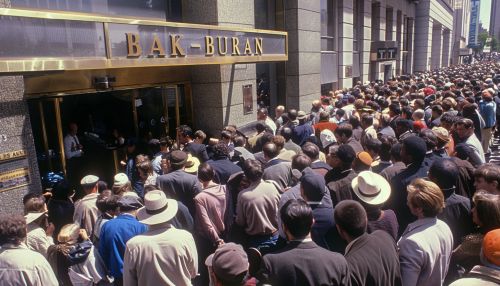Bank run
Overview
A bank run occurs when a large number of customers of a bank or another financial institution withdraw their deposits simultaneously over concerns of the bank's solvency. As more people withdraw their funds, the probability of default increases, prompting more people to withdraw their money, in a vicious cycle.


Causes of Bank Runs
Bank runs typically occur when depositors panic, fearing the potential insolvency of their bank and rush to withdraw their funds as quickly as possible. This panic may be triggered by various events, such as the failure of a related bank, a public rumor regarding the bank's insolvency, or a sudden economic downturn.
Economic Downturns
During periods of economic instability or recession, banks may experience runs as depositors fear the bank's potential insolvency. The risk of bank runs is particularly high during times of economic crisis, such as the Great Depression or the 2008 financial crisis.
Rumors and Speculation
Public confidence in a bank can be severely undermined by rumors or speculation about the bank's financial health. Even if these rumors are unfounded, they can cause a panic that leads to a bank run.
Failure of a Related Bank
The failure of one bank can instigate a bank run on other banks that are perceived to be similarly risky or unstable. This is particularly true in cases where the banks are interconnected due to their business dealings.
Effects of Bank Runs
Bank runs can have severe consequences for both the bank and the broader economy. For the bank, a run can lead to bankruptcy as the bank struggles to meet the sudden demand for withdrawals.
Impact on the Bank
A bank run can deplete a bank's cash reserves and lead to insolvency. As more depositors withdraw their funds, the bank may be forced to sell off assets or borrow money to meet the demand for withdrawals. If the bank cannot raise enough funds to meet its obligations, it may be forced to declare bankruptcy.
Impact on the Economy
Bank runs can also have a significant impact on the broader economy. As banks struggle to meet the demand for withdrawals, they may be forced to sell off assets, which can lead to a fall in asset prices. This can exacerbate an economic downturn, leading to a cycle of deflation and economic contraction.
Prevention and Mitigation of Bank Runs
Various strategies can be used to prevent or mitigate the effects of bank runs. These include deposit insurance schemes, banking regulations, and the role of a lender of last resort.
Deposit Insurance
Deposit insurance schemes can help prevent bank runs by guaranteeing that depositors will not lose their money even if the bank becomes insolvent. This can help maintain public confidence in the banking system and prevent panic withdrawals.
Banking Regulations
Banking regulations can also help prevent bank runs by ensuring that banks maintain sufficient reserves to meet their depositors' demands. Regulations may also require banks to maintain certain levels of capital to protect against potential losses.
Lender of Last Resort
In many countries, the central bank or another governmental agency acts as a lender of last resort, providing liquidity to banks in times of crisis. This can help prevent bank runs by ensuring that banks have access to sufficient funds to meet their depositors' demands.
Historical Examples of Bank Runs
Bank runs have played a major role in numerous financial crises throughout history. Some of the most notable examples include the bank runs during the Great Depression, the Northern Rock crisis in the UK, and the banking panic during the 2008 financial crisis.
Bank Runs During the Great Depression
The Great Depression saw a wave of bank runs across the United States. These bank runs were a major factor in the economic downturn and led to significant reforms in the banking sector, including the introduction of deposit insurance.
Northern Rock Crisis
In 2007, the UK bank Northern Rock experienced the first bank run in the UK in over 140 years. The bank's reliance on short-term funding left it vulnerable when credit markets seized up during the 2008 financial crisis.
2008 Financial Crisis
During the 2008 financial crisis, a number of banks experienced runs as depositors panicked over the banks' exposure to subprime mortgage loans. These bank runs were a major factor in the severity of the crisis and led to significant reforms in the banking sector.
